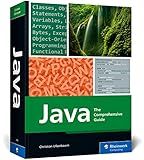Best Java Programming Books to Buy in January 2026

Java: The Complete Reference, Thirteenth Edition



Java for Beginners: Build Your Dream Tech Career with Engaging Lessons and Projects



Head First Java: A Brain-Friendly Guide



Java All-in-One For Dummies



Java Programming Language: a QuickStudy Laminated Reference Guide



Java: The Comprehensive Guide to Java Programming for Professionals (Rheinwerk Computing)



Java Coding Problems: Become an expert Java programmer by solving over 250 brand-new, modern, real-world problems



Learn Java with Projects: A concise practical guide to learning everything a Java professional really needs to know



Java: A Beginner's Guide, Tenth Edition


Polymorphism in Java can be implemented through method overriding and inheritance. Method overriding allows a subclass to provide a specific implementation of a method that is already defined in its superclass. This means that a method in a subclass can have the same name, return type, and parameters as a method in its superclass, but provide a different functionality.
To implement polymorphism in Java, you can create a superclass with a method that is meant to be overridden by subclasses. Then, create subclasses that extend the superclass and provide their own implementations of the overridden method. By creating objects of the subclass type and invoking the overridden method, you can achieve polymorphism in Java, where the behavior of the method is determined at runtime based on the type of object used to invoke it.
Polymorphism allows you to write more flexible and reusable code, as you can use a superclass type to refer to objects of different subclasses and have them behave differently based on their specific implementations. This helps in creating more maintainable and extensible code, making it easier to add new functionality in the future without modifying existing code.
What is the syntax for implementing polymorphism in Java?
In Java, polymorphism can be implemented through method overriding and method overloading. Here is the syntax for both:
Method Overriding:
class Animal { public void sound() { System.out.println("Animal makes a sound"); } }
class Dog extends Animal { @Override public void sound() { System.out.println("Dog barks"); } }
public class Main { public static void main(String[] args) { Animal animal = new Dog(); animal.sound(); // Outputs: Dog barks } }
Method Overloading:
class Calculation { public int add(int a, int b) { return a + b; }
public int add(int a, int b, int c) { return a + b + c; } }
public class Main { public static void main(String[] args) { Calculation calc = new Calculation(); System.out.println(calc.add(2, 3)); // Outputs: 5 System.out.println(calc.add(2, 3, 4)); // Outputs: 9 } }
In the above examples, the method sound() in the Dog class overrides the method sound() in the Animal class, and the add() method in the Calculation class is overloaded with two different sets of parameters. When invoking the method through a reference of the parent class (Animal or Calculation), the actual implementation from the child class (Dog) or the appropriate method with matching parameters will be executed, demonstrating polymorphic behavior.
What is the main benefit of using polymorphism in Java?
The main benefit of using polymorphism in Java is that it allows for more flexibility and reusability in code. Polymorphism allows objects to be treated as instances of their parent class, making it easier to create and use different types of objects without needing to modify existing code. This can help to reduce code duplication, increase code readability, and make programs more modular and flexible.
What is polymorphism and how to implement it in Java?
Polymorphism is the ability of objects to take on different forms or behaviors depending on the context in which they are used. In Java, polymorphism can be achieved through method overriding and method overloading.
Method overriding occurs when a subclass provides a specific implementation of a method that is already defined in its superclass. This allows objects of the subclass to be treated as objects of the superclass, providing a degree of flexibility and code reusability.
To implement method overriding in Java, you must define a method in a subclass that has the same signature (name, return type, and parameters) as a method in its superclass. The subclass method must use the @Override annotation to indicate that it is intended to override the superclass method.
Method overloading occurs when a class defines multiple methods with the same name but different parameters. This allows the same method name to be used in different contexts, enhancing code readability and maintainability.
To implement method overloading in Java, you must define multiple methods in a class with the same name but different sets of parameters. The compiler will determine which method to call based on the number and types of arguments provided.
Overall, polymorphism in Java allows for more flexible and versatile programming by enabling objects to exhibit different behaviors based on their context.
How to implement polymorphism in Java using instanceof operator?
Polymorphism in Java can be implemented using the instanceof operator along with method overriding. The instanceof operator is used to check if an object is of a particular class type.
Here's an example to demonstrate polymorphism using the instanceof operator:
- Create a superclass Shape with a method draw()
class Shape { public void draw() { System.out.println("Drawing a shape"); } }
- Create two subclasses Circle and Square that extend the Shape class and override the draw() method
class Circle extends Shape { @Override public void draw() { System.out.println("Drawing a circle"); } }
class Square extends Shape { @Override public void draw() { System.out.println("Drawing a square"); } }
- Create a main class with a method that accepts a Shape object and uses the instanceof operator to call the appropriate draw() method based on the object type
public class Main { public static void main(String[] args) { Shape circle = new Circle(); Shape square = new Square();
drawShape(circle);
drawShape(square);
}
public static void drawShape(Shape shape) { if (shape instanceof Circle) { ((Circle) shape).draw(); } else if (shape instanceof Square) { ((Square) shape).draw(); } else { shape.draw(); } } }
In this example, the drawShape() method accepts a Shape object and checks if it is an instance of Circle or Square. If it is, then the corresponding draw() method of that subclass is called. Otherwise, the superclass draw() method is called.
This way, polymorphism is achieved using the instanceof operator in Java.
How to achieve polymorphism in Java using inheritance?
Polymorphism in Java can be achieved using inheritance and method overriding. Here is an example of how to achieve polymorphism in Java using inheritance:
- Create a base class with a method that will be overridden in the child classes:
public class Animal { public void sound() { System.out.println("Animal makes a sound"); } }
- Create child classes that inherit from the base class and override the method:
public class Dog extends Animal { @Override public void sound() { System.out.println("Dog barks"); } }
public class Cat extends Animal { @Override public void sound() { System.out.println("Cat meows"); } }
- Create a main class to demonstrate polymorphism:
public class Main { public static void main(String[] args) { Animal animal1 = new Dog(); Animal animal2 = new Cat();
animal1.sound(); // Output: Dog barks
animal2.sound(); // Output: Cat meows
}
}
In this example, we have created a base class Animal with a method sound() that prints a generic sound message. We then created two child classes, Dog and Cat, that inherit from the Animal class and override the sound() method to provide specific sound messages for each animal.
In the Main class, we demonstrate polymorphism by creating instances of Dog and Cat but assigning them to variables of type Animal. When we call the sound() method on these variables, the overridden method in each child class is called, demonstrating polymorphism in action.
